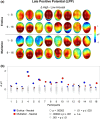A case-by-case analysis of EPN and LPP components within a "one-picture-per-emotion-category" protocol
- PMID: 39533163
- PMCID: PMC11870814
- DOI: 10.1111/psyp.14718
A case-by-case analysis of EPN and LPP components within a "one-picture-per-emotion-category" protocol
Abstract
Stimuli encountered in the environment are continuously evaluated according to their affective stimulus significance. Numerous event-related potential studies have shown that the early posterior negativity (EPN) and the late positive potential (LPP) are larger for high than low arousing emotional pictures. The group approach has been recently extended to the study of the individual case. Usually, many exemplars are used to represent an emotion category. Determining how many pictures are needed to reliably assess affective stimulus evaluation processes at the individual level is crucial when moving toward the goal of exploring idiosyncratic emotional stimuli. Accordingly, in the present study (N = 16), singular images displaying erotic, neutral, and mutilation content were shown 800 times while dense sensor EEG was recorded. At the group level, enhanced EPN and LPP amplitudes for high compared to low arousing stimuli emerged. At the single subject level, significantly larger amplitudes to the erotic than neutral image were observed in 15 out of 16 tests for the EPN and LPP components. Regarding the mutilation image, 15 participants showed a significant EPN effect, while the LPP effect was only found in 10 cases. Notably, emotional modulation of the EPN and LPP was stable over time. The present study contributes to the development of experimental designs tailored to the needs of the case-by-case approach. Since the process of affective stimulus evaluation is considered as a process common-to-all, the use of a singular stimulus exemplar may prove useful to investigate the idiosyncratic nature of emotion.
Keywords: EPN; ERPs; LPP; attention; case‐by‐case; emotion.
© 2024 The Author(s). Psychophysiology published by Wiley Periodicals LLC on behalf of Society for Psychophysiological Research.
Conflict of interest statement
The authors declare no conflicts of interest.
Figures





References
MeSH terms
Grants and funding
LinkOut - more resources
Full Text Sources

